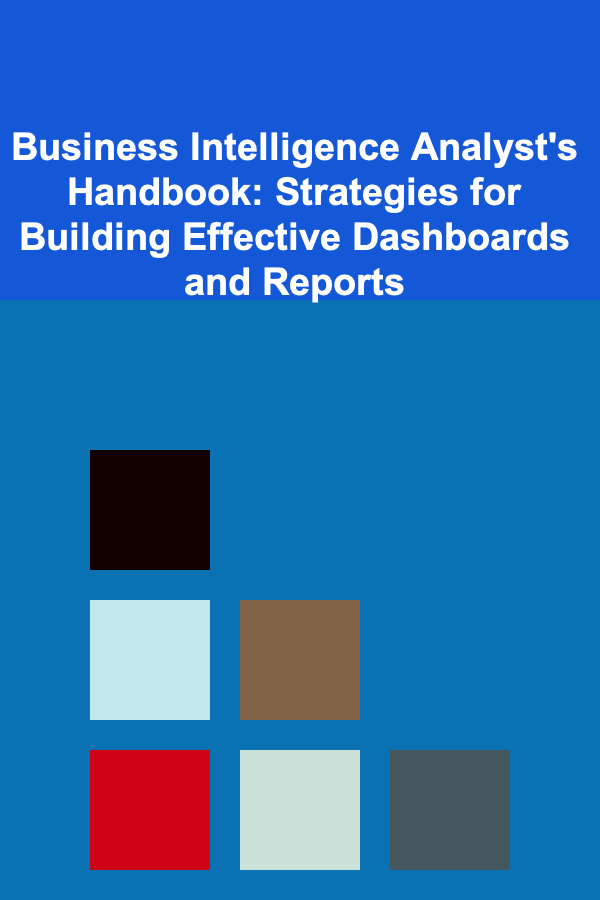
Business Intelligence Analyst's Handbook: Strategies for Building Effective Dashboards and Reports
ebook include PDF & Audio bundle (Micro Guide)
$12.99$11.99
Limited Time Offer! Order within the next:

Business Intelligence (BI) is all about transforming raw data into valuable insights that drive decision-making processes. One of the most critical tools for delivering insights is through dashboards and reports. As a Business Intelligence Analyst, mastering the creation of effective dashboards and reports is essential. This actionable guide will explore strategies to design and build dashboards and reports that are not only insightful but also user-friendly, actionable, and aligned with business objectives.
Understanding the Core Objective of Dashboards and Reports
The primary goal of dashboards and reports is to facilitate decision-making. A well-designed dashboard or report must effectively communicate key data points and insights in a manner that is easy to interpret and action. But before diving into the design, it's essential to understand the different objectives of dashboards and reports:
- Dashboards are designed for real-time monitoring and decision-making. They present key performance indicators (KPIs) and metrics at a glance and allow users to monitor business performance continuously. Dashboards are typically used for operational purposes and provide an overview of ongoing business processes.
- Reports tend to be more detailed and are typically used for deeper analysis. They might focus on historical data or provide comprehensive insights into a specific area, such as financial performance, sales trends, or customer behavior. Reports are often generated at regular intervals (e.g., daily, weekly, monthly) and are intended for strategic decision-making.
Understanding these distinctions is the first step in building effective BI tools that align with your organization's goals.
Know Your Audience: Tailoring Dashboards and Reports
The success of a dashboard or report largely depends on how well it meets the needs of its target audience. Tailoring your dashboards and reports to the specific needs of different user groups is a critical step in ensuring that the information presented is actionable.
2.1 Different User Needs
- Executives and Senior Management: Executives are generally interested in high-level metrics that indicate the overall health of the business. They typically look at KPIs related to revenue, profitability, and customer satisfaction. Dashboards for this group should prioritize simplicity, with an emphasis on clarity and ease of understanding. Use aggregated metrics, trends, and visualizations like bar charts, line graphs, and pie charts.
- Middle Management: Middle managers often need more detailed data to help them monitor day-to-day operations. Their dashboards or reports should provide insights into departmental performance, project statuses, and resource allocation. Filters and drill-down capabilities are essential for enabling these users to access more granular data.
- Data Analysts and Operational Teams: These users require more detailed and raw data for in-depth analysis. Reports should allow for detailed examination of trends, anomalies, and patterns. Dashboards for analysts should include features like interactive charts, customizable views, and data exploration tools.
2.2 Gathering User Feedback
Understanding the audience's needs requires ongoing engagement. Before designing any dashboard or report, it's important to consult with the end-users and gather feedback about what they need from the tool. Ask questions like:
- What are the most important metrics you need to track?
- What type of data visualization do you find most useful?
- How often do you need the data to be updated?
- Do you require drill-down capabilities, or is high-level data sufficient?
By understanding these preferences, you can tailor the design and functionality of your dashboards and reports accordingly.
Design Principles for Effective Dashboards
Designing an effective dashboard is an art and science combined. A well-designed dashboard is intuitive, easy to navigate, and visually appealing, ensuring that the key insights are immediately obvious.
3.1 Simplicity and Focus
The most important rule of dashboard design is simplicity. Dashboards that contain too much information can overwhelm users and obscure the key insights. Focus on displaying only the most critical data and metrics that align with your objectives. Limit the number of visualizations to those that truly add value.
- Minimalism: Avoid clutter by removing unnecessary elements. Keep the layout clean and straightforward.
- Clear Hierarchy: Organize information with a clear visual hierarchy. Place the most important data at the top or in the most prominent areas of the dashboard.
- Use of Space: Ensure that there is sufficient space around each visualization to make it easy to read and understand.
3.2 Consistent Visual Design
Consistency in visual design makes dashboards easier to read and interpret. Standardizing the colors, fonts, and shapes used in your visualizations will help users quickly grasp the information presented.
- Colors: Use colors wisely. For example, green can represent positive metrics, while red can signify negative outcomes. Be mindful of color-blind users by choosing color combinations that are distinguishable to everyone.
- Fonts: Use legible fonts and avoid excessive text. Prioritize readability and clarity.
- Visualization Types: Match the type of visualization with the data it represents. For example, use line graphs to show trends over time, bar charts for comparisons, and pie charts for proportional data.
3.3 Interactive Elements
Adding interactive elements such as filters, drill-downs, and hover-over tooltips can significantly enhance the functionality of a dashboard. These elements allow users to explore the data in greater detail and customize the view according to their needs.
- Filters: Allow users to filter data by date, region, product, or other variables. Filters provide flexibility and enable users to focus on specific segments of the data.
- Drill-downs: Drill-down capabilities let users explore data in more depth by clicking on elements of the dashboard. For instance, clicking on a regional performance metric could reveal more detailed sales data for that region.
- Dynamic Tooltips: Tooltips that appear when a user hovers over a data point can provide additional context, such as the exact number behind a bar or trend line.
3.4 Real-Time Data and Alerts
In many cases, dashboards need to present real-time or near-real-time data. This is especially true for operational dashboards used for monitoring business activities like sales, inventory levels, or website traffic. Real-time data can help teams act swiftly to address issues as they arise.
In addition, setting up automatic alerts based on specific thresholds (e.g., sales falling below a certain value) can proactively inform users about critical events.
Creating Impactful Reports
While dashboards are focused on real-time monitoring, reports provide in-depth analysis and a historical view of business performance. A report is typically used for periodic analysis and is more detailed than a dashboard.
4.1 Clarity in Reporting
Reports should present data in a clear, easy-to-understand format. Organize the report into sections, starting with an executive summary and then diving into more detailed findings.
- Executive Summary: Begin with a high-level overview of the report's key findings. This helps senior leaders quickly grasp the most critical insights.
- Contextualization: Provide context for the data by explaining any trends, anomalies, or outliers. Avoid letting the numbers speak for themselves; offer explanations that can guide the reader toward conclusions.
- Data Tables and Visuals: Combine tables with charts and graphs to present data clearly. Tables are helpful for displaying precise figures, while charts and graphs provide visual context and highlight trends.
4.2 Flexibility and Customization
Reports should be flexible enough to be customized based on the user's needs. Offering options such as filtering by time period, region, or department can make the report more relevant to different stakeholders.
- Export Options: Ensure that users can export reports to formats like PDF, Excel, or PowerPoint for further analysis or presentation.
- Automated Reporting: Automating the generation and distribution of reports can save time and ensure that stakeholders always have access to the latest insights.
Tools for Building Dashboards and Reports
There is a wide variety of tools available to Business Intelligence Analysts for creating dashboards and reports. The right tool for your organization will depend on factors such as the volume of data, complexity of analysis, and the specific needs of users.
- Power BI: A popular and powerful tool for creating interactive dashboards and reports. It integrates well with Microsoft products and offers a wide range of visualization options.
- Tableau: Known for its advanced data visualization capabilities, Tableau enables analysts to create highly interactive and visually appealing dashboards.
- Google Data Studio: A free tool that offers integration with Google products like Google Analytics and Google Sheets. It's great for teams already using Google's ecosystem.
- Qlik Sense: A self-service BI tool that allows users to create dashboards with a high level of interactivity. It supports both guided and self-service analytics.
Iterative Improvement: Test, Refine, and Optimize
The process of building dashboards and reports is iterative. Once a dashboard or report is created, it's crucial to test its effectiveness with users. Collect feedback, track how users interact with the dashboard, and make adjustments as needed.
- User Testing: Involve end-users in the testing phase to identify usability issues, unclear visualizations, or missing data points.
- Performance Monitoring: Ensure that dashboards and reports load quickly and perform well, especially when dealing with large datasets. Slow-loading dashboards can frustrate users and reduce adoption.
- Continuous Updates: As business needs evolve, so should your dashboards and reports. Regularly review and update them to ensure they remain aligned with business objectives.
Conclusion
Building effective dashboards and reports is a critical skill for any Business Intelligence Analyst. By understanding the needs of your audience, focusing on clear design principles, and using the right tools, you can create dashboards and reports that provide actionable insights, support decision-making, and drive business success. Continuous testing, iteration, and optimization will help ensure that your BI solutions remain relevant and impactful over time.

How to Clean and Maintain Your Home's Air Quality
Read More
How to Organize a Family Volunteering Day at Home
Read More
How to Organize Your Technology: Gadgets, Cords, and Accessories
Read More
How to Use Delivery Services to Handle Time-Consuming Errands
Read More
How to Use Furniture with Built-In Storage Effectively
Read More
Software Architect's Handbook: Best Practices for Building Sustainable Solutions
Read MoreOther Products

How to Clean and Maintain Your Home's Air Quality
Read More
How to Organize a Family Volunteering Day at Home
Read More
How to Organize Your Technology: Gadgets, Cords, and Accessories
Read More
How to Use Delivery Services to Handle Time-Consuming Errands
Read More
How to Use Furniture with Built-In Storage Effectively
Read More